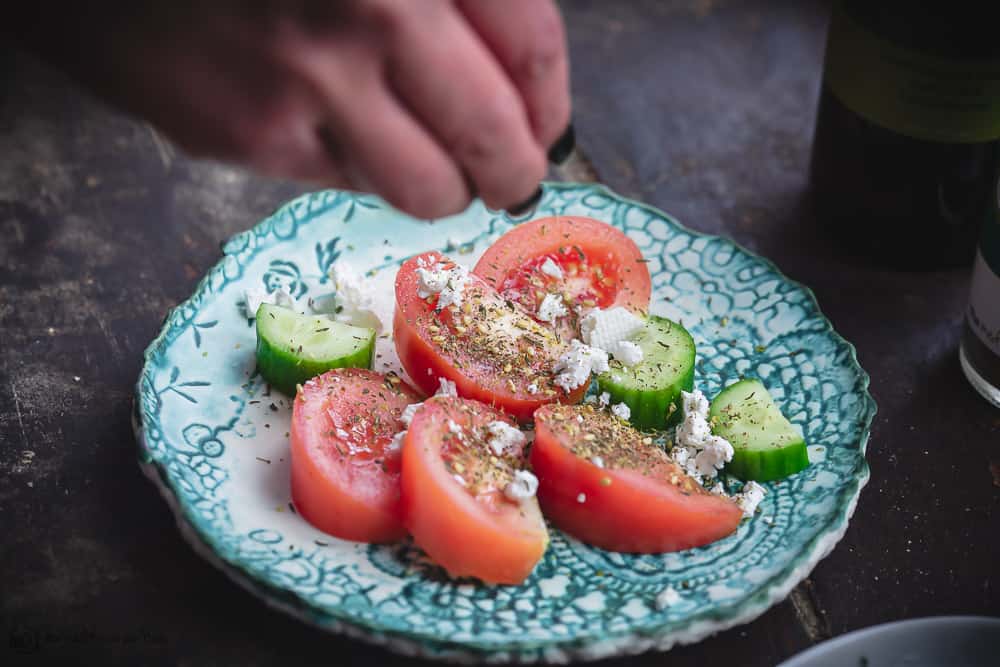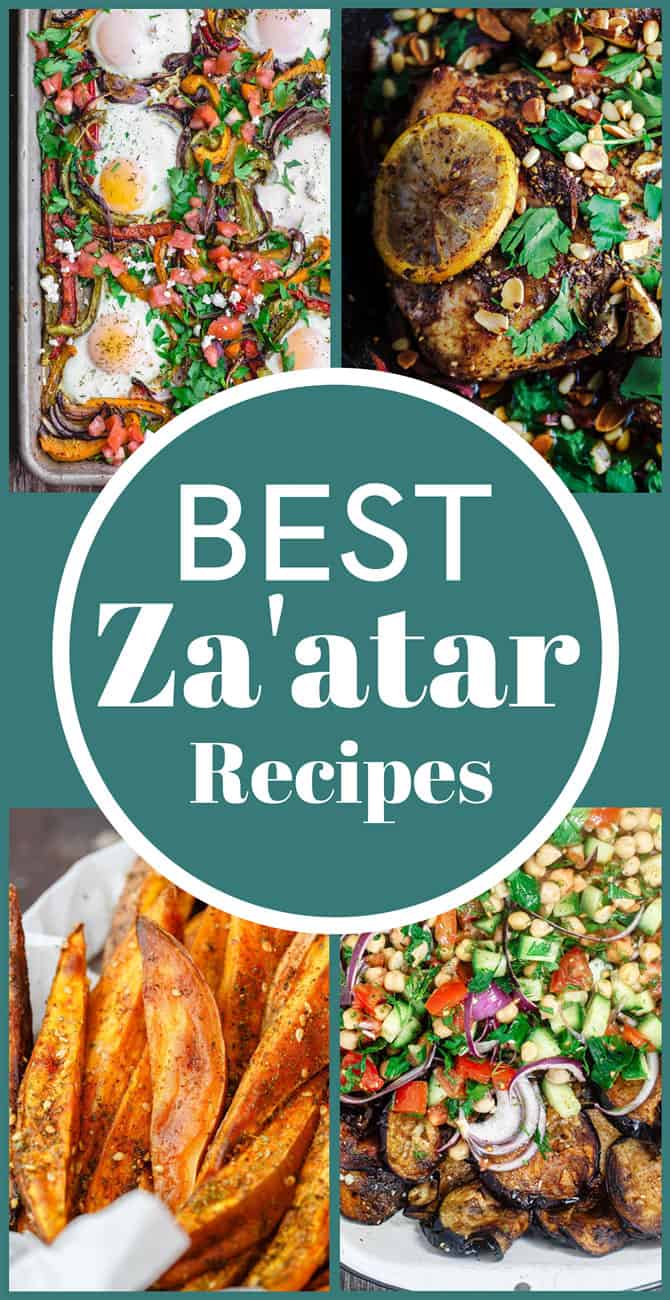If there is one seasoning blend I absolutely cannot live without, it’s za’atar! This aromatic Middle Eastern blend of herbs, sesame seeds, and sumac will transform your cooking. Not all za’atar is created equal, though. Today, let’s dig into what is za’atar (spice or herb?). What does quality za’atar consist of? And the many delicious ways to use it!
Be sure to grab my list of 11 BEST za’atar recipes below. From amazing salads to the best roast chicken, breakfast, and more!

What is za’atar (zaatar)?
I love highlighting my favorite Mediterranean pantry ingredients, like I do in my Aleppo pepper guide. Today, I’m sharing everything you need to know about one of the most-used seasonings in my spice cabinet, za’atar.
Za’atar (pronounced Zaah-tar) is most identified with Middle Eastern and Mediterranean cooking. A combination of herbs, sesame seeds, sumac, and salt, it is one of the world’s unique and best seasonings. It’s loaded with bold flavors, has great texture, and even boasts some health benefits–from soothing inflammation to boosting cognition!
Many don’t know this, but the Arabic word Za’atar (zaatar) also describes an actual herb that’s in the wild thyme family which starts its life looking more like oregano (Blends that stick to the traditional taste will include Mediterranean wild thyme in them.)

What’s in it? Not all za’atar is created equal
So, we said Zaatar is a combination of herbs, sesame seeds, and sumac (a tangy red spice from sumac berries – get more info about it in our sumac guide!). How much sumac? White or toasted sesame seeds? What else is added?
There are no official standards out there, and that’s why you’ll find different variations of zaatar seasoning on the market.
As someone who’s of Mediterranean origins and who has tried many blends over the years (more than I care to remember), I can tell you, not all za’atar is created equal. Taste, texture, and quality will vary a lot.
Sadly, many blends will not include quality herbs. To increase volume and lower prices, cheaper za’atar blends include a large amount of fillers in the form of wheat, flavored ground straw or husk. And many will substitute citric acid for sumac.

Quality all-natural za’atar seasoning and where to find it
You can find za’atar in the spice section at health food stores or Mediterranean and Middle Eastern grocery stores. My best advice to you is to look at the the label carefully and ask questions. Look for za’atar that contains quality wild thyme (or hyssop) and sumac (not citric acid.)
Make sure the ingredients are all natural and nothing else is added. Look at it carefully, it should have good texture and look more on the green side (like the picture above).
Let me tell you about the blend I use
The Mediterranean Dish za’atar is sourced from trusted suppliers, includes only quality all-natural ingredients, and stays true to traditional taste and texture. An aromatic blend with both earthy and subtle citrus undertones, and just a hint of nuttiness, it includes:
- High quality, fragrant French wild thyme, which adds robust flavor along with oregano.
- Toasted sesame seeds (as opposed to the standard white), which adds a sweet, nutty flavor
- A good amount of quality ground sumac from Mediterranean sumac berries, which adds a subtle lemony and earthy flavor; the perfect balance to the wild thyme and oregano. And a small pinch of kosher salt to round everything out.
Remember, many lower quality zaatar blends substitute citric acid for sumac and add other fillers like wheat and flavored straw to increase volume.
Where to Buy? If you live in the USA, you can find our all-natural za’atar at our online store.

How to use za’atar (zaatar): 13 BEST Za’atar Recipes
I use zaatar on a regular basis. It’s great to simply season some avocados or tomatoes for a snack (drizzle a little extra virgin olive oil), to generously season pillowy homemade bread rolls, to jazz up some breakfast eggs and spinach pasta, or to include with olive oil for dipping as part of a big Mediterranean spread.
But I also use it to season salads, meats and even fish. Here are 13 favorite recipes using za’atar:
- Grilled Eggplant Salad with Za’atar Pita Crisps
- Savory Galette with Summer Veggies and Za’atar
- Za’atar Roasted Chicken
- Chickpea Salad with Eggplants
- Olive Oil Baked Sweet Potato Fries

- Mediterranean Sheet Pan Baked Eggs & Veggies
- Za’atar Garlic Salmon and Veggies
- Manaqish (Za’atar Flatbread)

- Mediterranean Avocado Salad
- Mediterranean Sweet Potato Toast
- Mediterranean Breakfast Toast with Hummus
- Mediterranean Flat Bread with Arugula and Smoked Salmon
- Pita Breakfast Pizza with Za’atar

Head over to The Mediterranean Dish Store to grab some today!
Try our Ultimate Mediterranean Spice Bundle Or the Exotic 4 Bundle!

You may also like:
How to make dukkah (Egyptian Dukkah Recipe)

Thanks Suzy for all the info on this spice blend, definitely going to make it!
What a great resource this is! Za’atar is one of our favorite spices, so I loved learning all about it!
I am going to make this to step up my cooking game! It sounds like a great addition to so many dishes and a better use of spices.
Alright! Enjoy!
I’ve always wondered about this spice! What a great collection of recipes, too! Thank you!
Awesome, Tracy! Thanks for checking this out!
Za’atar is so amazing! I love putting it on my veggies, for an extra kick! I love the idea of putting this on sweet potato fries. I’ll have to give your recipe a try. 🙂
it really is! Thanks so much for checking this out!
i surely love this spice. I have used it before and love it. Can make too many delicious recipes with this spice. Goes with everything possible.You will love it.
All of these recipes have me drooling!
That’s the point 😉
Thanks for all the great tips! Ive never used zaatar before so this is a super helpful article. 🙂
Have never hear of zaatar until now! Can’t wait to try it out!
Oh I need to get me some of this and try it. I bet it is amazing.
My FAVORITE spice, this is such a great collection of recipes!
SO glad to know you’re selling a quality za’atar! Plus thanks for all the fabulous recipes!
My favorite way to use zaatar is to just mix it with olive oil and dip bread in it.
I love that! We do it a lot over here!
I was hoping to find three spices in one package of Coriander, Turmeric and Za’atar?
Thank you!
YES! That is available. Head over to the store and select create your own 3-pack: https://shop.themediterraneandish.com/product/create-3-pack/ you can add those very spices and take advantage of the discount. Also available in our Ultimate Spice Bundle: https://shop.themediterraneandish.com/product/ultimate-mediterranean-spice-bundle/
Where in Australia would I find a good quality Zaatar spice?love your recipes. I ‘ve just found your site and have tried a few dishes, Zaatar would be handy to have in pantry. Thank you. GAZZ
Hi Gail, I’m not familiar with the Australian market, but if you have some health food stores or even some Middle Eastern or Mediterranean grocery stores, you might find it there. I would look at the ingredient list to make sure it’s what you want.
Not a spice. Do you not know the difference between spice & herb? The Arabic people I worked for in a cafe (from Jordan, Palestine, Israel, Egypt & Yemen) used zaatar alot! They even ate it with olive oil & pita for breakfast! Delicious?
Jeanne, it’s clear you did not read the full post. By the way, I’m Egyptian myself and my husband’s family are Jordanian, there is nothing we consume more than za’atar 🙂 The word za’atar refers to both a spice blend or seasoning and it also refers to the actual herb, a Mediterranean wild thyme that is also a component of the spice blend (first part of the post discusses this under “What is za’atar?”). And yes, one of the ways it’s enjoyed is simply with pita bread and olive oil as mentioned later in the post (under how to use Za’atar.) Enjoy!